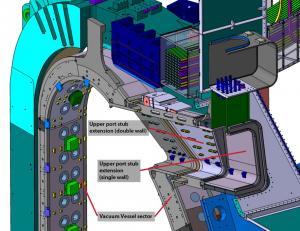Vacuum vessel component passes pressure equipment tests
9 Jan 2017
-
Sabina Griffith
Extending out from the openings in the ITER vacuum vessel (or "ports") are components called port stub extensions that will be welded to the vacuum vessel sectors before the assembly of the main vessel in the pit. The first completed port stub extension—for upper port #12—has successfully passed pressure and helium leak tightness tests.
This 20-tonne component will "fit" onto upper port #12. Following final machining and testing, it will be shipped to Korea to be welded to vacuum vessel sector 6.
The tension was tangible as observers assembled at the test stand saw the pressure gauge reach the 3.78 MPa mark.
Would there be any trace of pressurized water escaping the system? The tolerances on the massive double-wall stainless steel structure were tight, the welding a challenge. After half an hour of mandated holding time, with all eyes on the gauge, there was a collective sigh of relief. The full pressure test of ITER's first completed upper port stub extension (#12) had been completed successfully.
The upper port stub extension is made of single and double-wall sections. Not pictured is the port extension that will be welded to the port stub in the the Tokamak Pit and that will connect to the cryostat through cryostat ducts.
The ITER vacuum vessel has 44 openings, or ports, on three levels (lower, equatorial and upper) that are used for equipment installation, utility feedthrough, vacuum pumping, and access into the vessel for maintenance. The upper ports are characterized by a trapezoidal/rectangular cross-section due to a slight upward slant. This has to be taken into account in the design of their port structures, including port stub extensions and port extensions. Each port stub extension includes double-wall and single-wall parts (see diagram).
In respect of French regulations on pressure equipment (ESPN), which apply to the ITER vacuum vessel, a full pressure test followed by a helium leak test to confirm the high vacuum tightness of the component were performed in the presence of an Agreed Notified Body* (ANB) before the final machining of upper port stub extension #12.
The tests were carried out at MAN Diesel and Turbo in Deggendorf, Germany, subcontractor to the Efremov Institute in Russia. Russia is responsible for the supply of 100% of the upper ports.
The tests were performed at the end of last year on the premises of the German company MAN Diesel and Turbo in Deggendorf (the main sub-supplier for the port stub extensions) as part of Russia's procurement of the upper ports. The main supplier for this procurement is the Efremov Institute in Saint Petersburg.
*An Agreed Notified Body (ANB) is a private company authorized by the French Nuclear Regulator ASN to assess the conformity of components in the pressure equipment category (ESPN).
The test campaign will be followed by some final machining and the integration of the single wall part before the comprehensive final testing of the complete assembly. When completed, the 20-tonne stub extension will be shipped to Hyundai Heavy Industries in South Korea where it will be mounted on vacuum vessel sector 6. It is expected to arrive by June of this year.
*An Agreed Notified Body (ANB) is a private company authorized by the French Nuclear Regulator ASN to assess the conformity of components in the pressure equipment category (ESPN).




